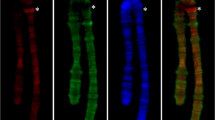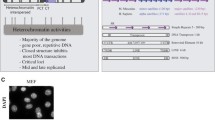Abstract
The descriptive term “heterochromatin” was introduced by the botanist Emil Heitz in 1928 for chromosomal regions that remain condensed during interphase and stain intensively in contrast to euchromatin. Later a distinction was made between facultative heterochromatin (a transient state) and constitutive heterochromatin (Brown, 1966). The constitutive heterochromatin is a permanent entity of a chromosome and according to text book opinion considered “to be DNA that is never transcribed in any cell” (Alberts et al., 1983). Even more, the possibility was suggested “that constitutive heterochromatin per se has no function in either development or evolution” (John, 1988). It is a constituent of both plant and animal genomes. For mammals, the gonosomal c-heterochromatin of the European field vole Microtus agrestis has been considered typical for constitutive heterochromatin in general: it is C-band positive, late replicating, and transcriptionally inactive in various tissues (Sieger et al., 1970).
Access this chapter
Tax calculation will be finalised at checkout
Purchases are for personal use only
Preview
Unable to display preview. Download preview PDF.
Similar content being viewed by others
References
Csink AK, Sass GL, Henikoff S (1997). Drosophila heterochromatin: retreats for repeats. In: van Driel R, Otte AP, eds. Nuclear Organization, Chromatin Structure, and Gene Expression. Oxford University Press, pp. 223–235.
Daniels GR, Deininger PL (1985). Repeat sequence families derived from mammalian tRNA genes. Nature 317: 819–822.
Dimitri P, Junakovic N (1999). Revising the selfish hypothesis–new evidence on accumulation of transposable elements in heterochromatin. Trends Genet 15: 1123–1124.
Henikoff S (2000). Heterochromatin function in complex genomes. Biochimica et Biophysika Acta 1, 470: 1–8.
Holmquist GP (1992). Chromosome bands, their chromatin flavors, and their functional features. Am J Hum Genet 51: 17–37.
Hughes DC (2000). MIRs as agents of mammalian gene evolution. Trends Genet 16: 60–62.
Jenuwein T (2002). An RNA-guided pathway for the epigenome. Science 297: 2215–2218.
John B (1988). The biology of heterochromatin. In: Verma RS, ed., Heterochromatin: Molecular and Structural Aspects, Cambridge University Press, pp. 1–147.
Kalscheuer V, Singh AP, Nanda I, Sperling K, Neitzel H (1996). Evolution of the gonosomal heterochromatin of Microtus agrestis: rapid amplification of a large, multimeric, repeat unit containing a 3.0-kb (GATA) 11 -positive, middle repetitive element. Cytogenet Cell Genet 73: 171–178.
Kazazian HH, Moran JV (1998). The impact of L1 retrotransposons on the human genome. Nat Genet 19: 19–24.
Kerem B, Kottusch-Geiseler V, Kalscheuer V, Goitein R, Sperling K, Marcus M (1988). DNase I sensitivity of Microtus agrestis active, inactive and reactivated X chromosomes in mouseMicrotus cell hybrids. Chromosoma 96: 277–230.
Korenberg JR, Rykowski MC (1988). Human genome organization: Alu, Lines, and the molecular structure of metaphase chromosome bands. Cell 53: 391–400.
Kunze B, Weichenhan D, Virks P, Traut W, Winking H (1996) Copy number of a clustered long-range repeat determine C-band staining. Cytogenet Cell Genet 73: 86–91.
Nanda I, Neitzel H, Sperling, Studer R, Epplen JT (1988). Simple GATA/GACA repeats characterize the X chromosomal heterochromatin of Microtus agrestis, European field vole (Rodentia, Cricetidae). Chromosoma 96: 213–219.
Neitzel H, Kalscheuer V, Henschel S, Digweed M, Sperling K (1998). Beta-heterochromatin in mammals: evidence from studies in Microtus agrestis based on the extensive accumulation of L1 and non-L1 retroposons in the heterochromatin. Cytogenet Cell Genet 80: 165–172.
Neitzel H, Kalscheuer V, Singh AP, Henschel S, Sperling K (2002). Copy and paste: the impact of a new non-L1 retroposon on the gonosomal heterochromatin of Microtus agrestis. Cytogenet Genome Res 96: 179–185.
Ostertag EM, Kazazian HH Jr (2001). Biology of mammalian L1 retrotransposons. Annu Rev Genet 35: 501–538.
Redi CA, Garagna S, Zacharias H, Zuccotti M, Capanna E (2001). The other chromatin. Chromosoma 110: 136–147.
Singh AP, Maerzke S, von Deimling O, Raman R, Sperling K, Neitzel H (1993). Oocytes from pachytene to dictyotene can easily be analysed in neonatal rodents. Chromosome Res 1: 209–312.
Schulze I (2000). Untersuchung der Transkriptionsaktivität und des Replikationsverhaltens des konstitutiven Heterochromatins and des Tiermodells Microtus agrestis. Inaug. Dissertation, Humboldt-Universität zu Berlin.
Sieger M, Pera F, Schwarzacher WG (1970). Genetic inactivity of heterochromatin and heteropycnosis in Microtus agrestis. Chromosoma 29: 349–364.
Singh A, Henschel S, Sperling K, Kalscheuer V, Neitzel H (2000). Differences in the meiotic pairing behavior of gonosomal heterochromatin between female and male Microtus agrestis: implications for the mechanism of heterochromatin amplification on the X and Y. Cytogenet Cell Genet 9: 253–260.
Soares MB, Schon E, Efstratiadis (1985). Rat LINE1: the origin and evolution of a family of long interspersed middle repetitive DNA elements. J Mol Evol 22: 117–133.
Sperling K (1982). Cell cycle and chromosome cycle: morphological and functional aspects. In: Rao PN, Johnson RT, Sperling K, eds. Premature Chromosome condensation. New York: Academic Press, pp. 43–78.
Sperling K, Marcus M (1994). Mapping of genetic activity on mammalian chromosomes. Chromosomes Today 8: 169–178. G Allen and Unwin.
Sperling K, Kerem BS, Goitein R, Kottsuch V, Cedar H, Marcus M (1985). DNase I sensitivity in facultative and constitutive heterochromatin. Chromosoma 93: 38–42.
Sperling K, Kalscheuer V, Neitzel H (1987). Transcriptional activity of constitutive heterochro- matin in the mammal Microtus agrestis (Rodentia, Cricetidae). Exp Cell Res 173: 463–472.
Sperling K, Kalscheuer V, Kottusch-Geiseler V, Neitzel H (1989). Genetic activity of the constitutive heterochromatin in mammals. Chromosomes Today 10: 83–89.
Author information
Authors and Affiliations
Editor information
Editors and Affiliations
Rights and permissions
Copyright information
© 2004 Springer Science+Business Media Dordrecht
About this paper
Cite this paper
Sperling, K., Henschel, S., Schulze, I., Neitzel, H. (2004). Constitutive Heterochromatin of Microtus agrestis: Molecular Organization and Genetic Activity in Mitotic and Meiotic Cells. In: Schmid, M., Nanda, I. (eds) Chromosomes Today. Springer, Dordrecht. https://doi.org/10.1007/978-94-017-1033-6_22
Download citation
DOI: https://doi.org/10.1007/978-94-017-1033-6_22
Publisher Name: Springer, Dordrecht
Print ISBN: 978-90-481-5855-3
Online ISBN: 978-94-017-1033-6
eBook Packages: Springer Book Archive




